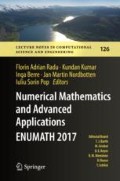Abstract
Based on the Hellinger-Reissner principle, accurate stress approximations can be computed directly in suitable H(div)-like finite element spaces treating conservation of momentum and the symmetry of the stress tensor as constraints. Two stress finite element spaces of polynomial degree 2 which were proposed in this context will be compared and relations between the two will be established. The first approach uses Raviart-Thomas spaces of next-to-lowest degree and is therefore H(div)-conforming but produces only weakly symmetric stresses. The stresses obtained from the second approach satisfy symmetry exactly but are nonconforming with respect to H(div). It is shown how the latter finite element space can be derived by augmenting the componentwise next-to-lowest Raviart-Thomas space with suitable bubbles. However, the convergence order of the resulting stress approximation is reduced from two to one as will be confirmed by numerical results. Finally, the weak stress symmetry property of the first approach is discussed in more detail and a post-processing procedure for the construction of stresses which are element-wise symmetric on average is proposed.
Access this chapter
Tax calculation will be finalised at checkout
Purchases are for personal use only
References
D.N. Arnold, F. Brezzi, J. Douglas, PEERS: a new mixed finite element for plane elasticity. Jpn. J. Appl. Math. 1, 347–367 (1984)
D.N. Arnold, R.S. Falk, R. Winther, Finite element exterior calculus, homological techniques, and applications. Acta Numerica 15, 1–155 (2006)
D. Boffi, F. Brezzi, M. Fortin, Reduced symmetry elements in linear elasticity. Commun. Pure Appl. Anal. 8, 95–121 (2009)
D. Boffi, F. Brezzi, M. Fortin, Mixed Finite Element Methods and Applications (Springer, Heidelberg, 2013)
Z. Cai, G. Starke, Least squares methods for linear elasticity. SIAM J. Numer. Anal. 42, 826–842 (2004)
A. Ern, M. Vohralík, Polynomial-degree-robust a posteriori error estimates in a unified setting for conforming, nonconforming, discontinuous Galerkin, mixed discretizations. SIAM J. Numer. Anal. 53, 1058–1081 (2015)
J. Gopalakrishnan, J. Guzmán, Symmetric nonconforming mixed finite elements for linear elasticity. SIAM J. Numer. Anal. 49, 1504–1520 (2011)
R. Stenberg, Postprocessing schemes for some mixed finite elements. Math. Model. Numer. Anal. 25, 151–167 (1991)
Author information
Authors and Affiliations
Corresponding author
Editor information
Editors and Affiliations
Rights and permissions
Copyright information
© 2019 Springer Nature Switzerland AG
About this paper
Cite this paper
Kober, B., Starke, G. (2019). Strong vs. Weak Symmetry in Stress-Based Mixed Finite Element Methods for Linear Elasticity. In: Radu, F., Kumar, K., Berre, I., Nordbotten, J., Pop, I. (eds) Numerical Mathematics and Advanced Applications ENUMATH 2017. ENUMATH 2017. Lecture Notes in Computational Science and Engineering, vol 126. Springer, Cham. https://doi.org/10.1007/978-3-319-96415-7_28
Download citation
DOI: https://doi.org/10.1007/978-3-319-96415-7_28
Published:
Publisher Name: Springer, Cham
Print ISBN: 978-3-319-96414-0
Online ISBN: 978-3-319-96415-7
eBook Packages: Mathematics and StatisticsMathematics and Statistics (R0)

